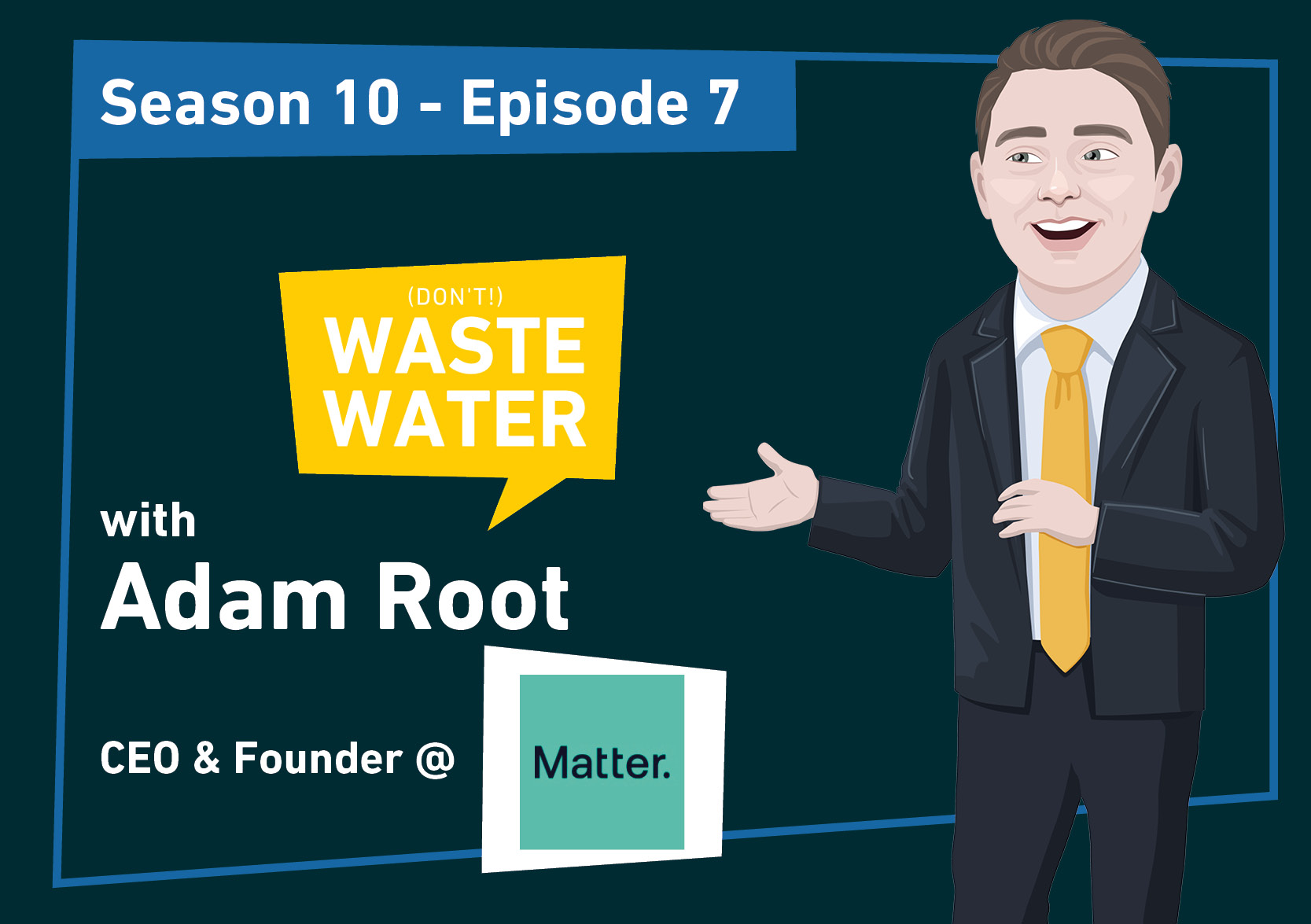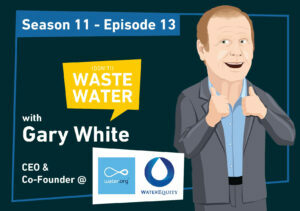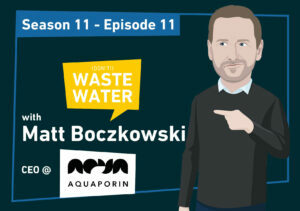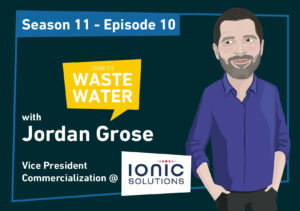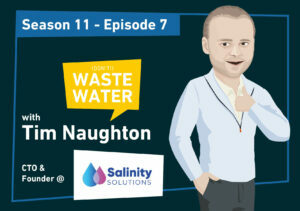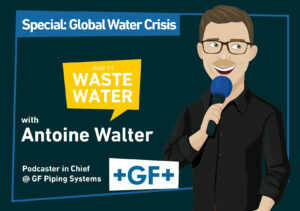It’s not the plastic straws! The greatest threat to the Oceans that’s living in all our homes is more discreet but much more harmful: it’s the washing machine. 30% of the plastic that enters the sea every year is actually microplastics, and a good chunk of it gets emitted when we wash synthetic fabric at home. What can and shall we do about it? Let’s find out:
with 🎙️ Adam Root – CEO & Founder at Matter
💧 Matter is an innovation company pioneering technology solutions for capturing, harvesting, and recycling microplastics
What we covered:
🚀 How Adam Root’s Brainchild is Revolutionizing Microplastics: Get the 101 on Matter, the company that’s making waves in microplastics and microfluids tech.
🌱 Why Matter Exists: Uncover the roots of Adam’s inspiration and the problem-solving DNA that fuels this groundbreaking venture.
🔬 What Micropollutants Mean for You and the Planet: Decode the buzzwords—circular economy, biosphere vs. technical sphere—and discover Matter’s mission to clean up our act.
💼 How Matter Slices the Business Pie: Dive into the four core segments of Matter’s business, from the Gulp system to legislation and beyond.
🔄 What Matter Does with Captured Material: Meet Matter Inside, Matter Industries, and Materials—Matter’s trifecta for turning waste into gold.
🎯 Why Juggling Business Challenges is Matter’s Sport: Peek into the hurdles of managing diverse applications and how Matter’s lean team tackles them.
🏁 What Sets Matter Apart in the Market: Explore the competitive landscape, market dynamics, and how rivalry is actually a boon for awareness.
🤝 How Matter Plays the Business Game: Unravel the business model, licensing strategies, and partnerships that are setting Matter up for global impact.
💡 Why Matter’s Innovation is a Game-Changer: Get the lowdown on Matter’s unique problem-solving approach, their patents, and the secret sauce of relationship-building.
🎤 What Matter Aims to Achieve at Conferences: Decode the goals for conference appearances, investor relations, and market opportunities that are on the horizon.
🔮 Why Matter’s Future is Brighter Than Ever: Gaze into the crystal ball—education, R&D, legislation, and sustainability are all in the cards.
🌟 How Matter Plans to Conquer the World: Wrap up with a glimpse into Matter’s sky-high ambitions for growth and scaling. Get ready; the future is limitless!
Resources:
🔗 Have a look at Matter‘s website
🔗 Come say hi to Adam on Linkedin

is on Linkedin ➡️
Full Video:
Table of contents
- What we covered:
- Resources:
- Full Video:
- Editorial: Microplastics’ Threat to the Oceans
- Introducing: Adam Root, CEO & Founder of Matter
- Introducing Gulp: Matter’s microplastics filter
- France as a fast-mover of microplastics regulations
- Catching the microplastics in washing machine effluents
- The filtration landscape is rapidly evolving
- What is Matter’s competition?
- Option 3 – Upstream or Downstream Removal
- Recovering resources from Microplastics
- What is Matter’s long-term Vision?
- What’s Matter’s Business Model?
- What’s Matter’s Special Sauce?
- A special Thanks to our Sponsor: Sciens Water
- Interviewing Adam Root at the Rethinking Water Conference in New York
- Matter’s next steps in Microplastics Removal
- Microplastics Removal: Today’s Conclusion
- Other Episodes:
Editorial: Microplastics’ Threat to the Oceans
How can we be genuinely wrong all the time? Remember when I found out that peeing under the shower once a day every day had the same environmental benefits as refusing to eat three chocolate tiles a year?
Well, it once again looks like these super ecological moves we think we do when we switch plastic straws for wood or metal ones are almost negligible compared to the giant polluter we all have sitting in our basements: the washing machine.
There’s more than one reason for that, by the way, but we’ll come back to that.
94% of the pieces in the Great Pacific Garbage Patch are Microplastics
For now, picture this: You’re sailing through the azure waters of the Pacific, the sun kissing your skin and the salty breeze filling your lungs. It’s paradise! But while you would expect me to tell now that your boat will soon collide with the Great Pacific Garbage Patch, a floating island of plastic twice the size of Texas. I’d rather encourage you to look up that Garbage Patch’s composition because you might be up for a double rickroll. As that study published in Nature shows, the patch’s not really made of these plastic bottles you’d expect but of abandoned fishing gear. That’s Rickroll number one, and you know about it if you’ve watched Seaspiracy. But rickroll number two is that 8% of the patch in weight and 94% in pieces is actually microplastics!

Indeed, every year, 8 million metric tons of plastic enter our oceans. That’s equivalent to dumping a garbage truck full of plastic into the sea every minute. But here’s the kicker: it’s not just the plastic bottles and bags that are the culprits. About 30% of our plastic pollution of the oceans is actually microplastics.
Microplastics are found everywhere on Earth
These tiny fragments are basically everywhere. They’ve been found in the Mariana Trench, the deepest part of the ocean, and even in Arctic ice!
While we’re at it, let’s look at some more numbers. A study by the Ellen MacArthur Foundation predicts that by 2050, there will be more plastic in the ocean than fish, by weight. By weight! And it’s not just marine life that’s at risk; it’s also the entire ecological services of Oceans that are threatened by these intruders. In practical terms, microplastics have gone full circle and made their way into our food chain. They’ve been found in everything from sea salt to beer, and yes, even in the seafood that ends up on our plates.
But where do these microplastics come from? I mean, it can’t be the straws anymore, as even McDonald’s removed them. Well, it could be these exfoliating scrubs you love, which can contain up to 2.8 million microbeads per bottle. But there, as well, the cosmetics industry makes some efforts to reduce or replace them.
Washing machines release up to 700’000 microplastics per 6kg wash
So why do I finger-point the washing machine? Well, every time you wash that cozy fleece jacket, a good chunk of microplastics are released into the waterways. How much exactly? According to this study published in Nature, 124 to 308 mg per kg of washed fabric. Which makes for about 700,000 microscopic plastic fibers per average 6 kg load of laundry, according to PlanetCare.
What’s more, is that these particles are too small to be filtered out by wastewater treatment plants, so even if they belong to the 55% of sewage that’s taken care of worldwide before discharge, they still end up in our oceans, where they are ingested by marine life, causing everything from hormonal imbalances to death.
So, indeed, we have a problem, to say the least. Now the question is, how to tackle it: but before answering that one, I need to introduce you to Adam Root, the CEO and founder of Matter.
Introducing: Adam Root, CEO & Founder of Matter
Adam Root: Matter is a microplastic technology company, which focuses on the capture, the harvest, and the recycling of microfluids. We work very, very heavily on… Our whole business is basically between 20mm and smaller. So very small stuff. Specifically around… Around the water space, but we’re also now moving into air and industrialization of the technology that we’ve developed.
Antoine Walter: Where does the idea come from? What triggers you to go into that field?
Adam Root: The original concept, I’m an engineer by training. I was at General Electric and GE and then was at Dyson. After that, my whole kind of background is problem solving. And I just saw this huge challenge that is micropollutants we’re seeing now becoming a rather large industry.
But the very beginning, for me, it was all about trying to solve a problem.
Antoine Walter: Can we define micropollutants? Because depending on the side of the Atlantic you’re on, depending on where you are, it might be very different. So what should be your definition?
Adam Root: My position on this is quite, um, holistic in many ways.
I focus very heavily on circular economy and specifically cradle to cradle. I see the world in two spheres. in the biosphere and the technical sphere. The biosphere, we learn about at school, is the nitrogen cycle, and the technical sphere effectively being the materials that humanity has created, which are completely independent for what’s happening in the natural world.
They don’t break down naturally over a period of time, which is in sync with the rest of the planet. We can see that prevalent. Plastic is a, is a very key example of this. Um, it’s a wondrous material, very lightweight, very cheap. However, it shouldn’t be in our air, it shouldn’t be in our water, it certainly shouldn’t be in our foods.
We have a microplastics problem. But do we have a solution?
So there, we’ve, I think, outlined the problem, and you get a better understanding on why Adam wanted to take it on. But let’s dig in and look into the specifics of Matter. What does Matter do!
Adam Root: We have four sections of our business. And two of them are based around, um, laundry. We have, uh, developed a system called Gulp. If you go to gulp. online, you’ll be able to see that there’s a retrofit washing machine filter we’ve created.
And that can capture microplastic from your clothes.
Introducing Gulp: Matter’s microplastics filter
If you’re curious about Gulp, it used to be live on Kickstarter; now it’s under production and should start delivering soon, I’ve placed a link in the description, I get zero cent if you order, as always, I don’t expect money from you, but if you like this kind of content, please hit the like button and subscribe to this channel.
Back to Gulp, when you look it up, can you tell that Adam is a former Dyson employee? It shows, right?
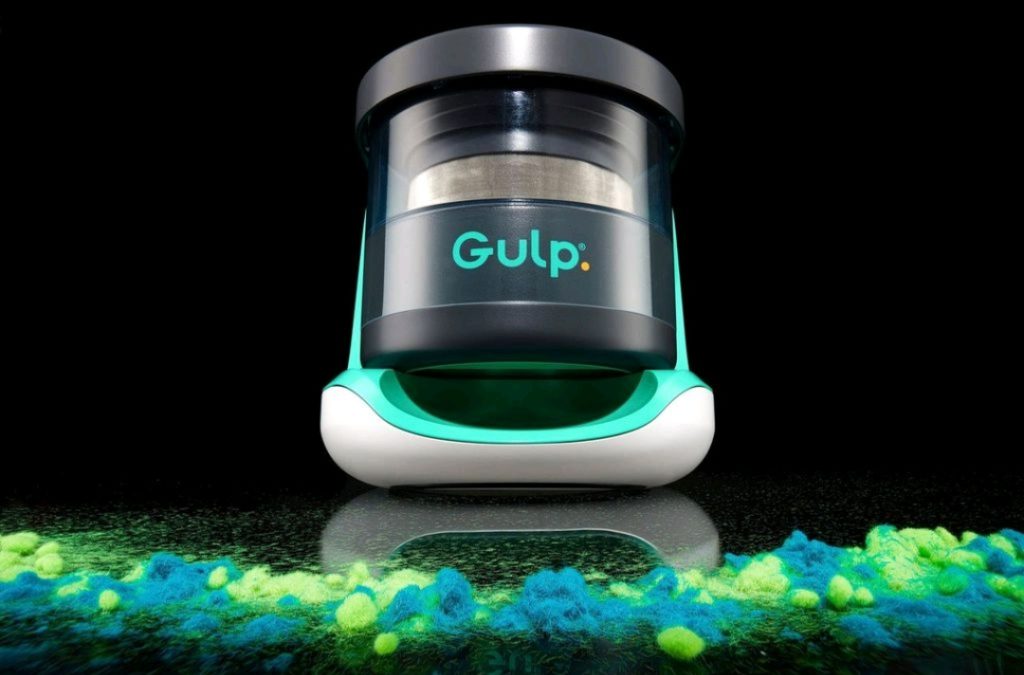
But let me stop interrupting, because Adam sees good news in some recent policy moves.
France as a fast-mover of microplastics regulations
Adam Root: It will be illegal in 2025 in France to buy a washing machine without a microplastic filter. And we’ve got some of the most advanced technology in the world to be able to do that. We’re also partnering with global brands to install that technology inside the washing machines.
When you buy a new washing machine, that will become included. And that meets the new legislation that’s coming in place in California now for 2029. That technology now scales into industrial applications. So that’s looking at wastewater treatment plants, textiles factories. The technology we’ve developed is not necessarily specific to micropollutants.
We’ve picked micropollutants because I believe that’s a real challenge that we need to solve, but I could use it for dairy or oil and gas. Or any application,
Matter’s differentiated technology to tackle micropollutants
Antoine Walter: What’s the technology?
Adam Root: Fundamentally, what we’ve developed is a high efficient system that’s low pressure consumption, low energy use, and that’s scalable.
So it’s a dynamic filtration system that uses a, a mixture of inertial separation, like a back washing technology we call regenerative pressure consumption. And that as a combination of all those different technologies, allows us to extract the material with no disposal parts. It’s not. High energy like normal cyclonic systems.
It’s not using disposables like a membrane or it doesn’t use chemicals like collagorants So it weaves a needle between the three different technologies to have no disposal parts No costs associated with the consistent running in the machine And that’s what we’ve got about nine patterns around there and we’re continuing to grow into different applications as we scale And that looks at the bypass and all the different complexities that are involved in actually creating a system.
Catching the microplastics in washing machine effluents
To understand what we discuss here, let me draw it for you. We’ve got a washing machine that’s discharging quite a bunch of microplastics to the sewer. Over 700,000 individual fibers per 6kg wash, as we’ve seen in the introduction.
Adam’s take with Gulp is to have an external filter sitting on top or next to the washing machine. The advantage is that it doesn’t impact the existing machine, it offers some design flexibility, and, as we just heard, it sounds pretty efficient in all dimensions.
Option 1 – Standalone hardware filters (PlanetCare, Samsung, Matter)
As, again, I have no stakes in Matter, I can easily point out that it’s not the only company proposing that approach; if there’s a regulation coming up, there’s a market: that makes sense. That’s how companies like Samsung announced at CES 2023 a new solution, while another company, PlanetCare is already in market with an external filter. But there still are some notable differences here. First, that one is powerless, so it runs solely on the legacy water pressure at the outlet of the washing machine, and second, it features a cartridge. Every 15 to 20 cycles, you’ll have to change it. That raises some more questions: how do you ensure that people effectively replace that cartridge? What happens if they don’t? And I don’t know for you, but for us here, with a family of five and small children that love tomato sauce and playing outdoors, that cartridge would probably not even last a month.
But the external filters themselves are not the only option. Why could a brand-new washing machine not simply come up with an internal filter, that would do the same job?
Matter works on that solution as well, by supplying its technology to third parties:
Option 2 – Built-in filters in washing machines (Beko, Matter Inside…)
Adam Root: So we call it Matter Inside, which is basically like, imagine Intel inside as a model. So it’s our technology and other people’s products. We work with supply chain and on a licensing model.
And as for the external filter, some market players are already equipped with their own solution, like Beko, with its “Fiber Catcher” technology. On paper, that one looks really good: it only activates itself if the machine is running a synthetic clothing program to optimize its lifespan. But as for the PlanetCare one we discussed minutes ago, it runs on a cartridge as well, with an expected lifetime of 6 months.
Replacing the cartridge costs 20 euros, and you can upcycle the collected fiber by returning the used cartridge to Beko for free, assuming you download the paperwork from their website.
Is a cartridge solution realistic for a real-world family?
Yet, there’s probably a real-world limitation to that approach. I don’t know for you, but here at home, when we run our laundry, we’re sorting stuff by colors, and that’s it. We don’t double sort and then also put synthetics on one hand and other stuff in a different basket. All that can be washed at a given temperature will be washed at that said temperature, and the “mixed stuff” program is clearly our favorite. Yes, we’re now discussing laundry tips on that channel. Did you expect it? Not me, honestly.
But that means that if we were running the Beko approach, for that “mixed stuff” the filter wouldn’t be activated, and we would keep discharging microplastics to the sewer.
That’s a limitation of the technology Beko picked; it rapidly gets clogged by all the other kinds of fibers, especially cotton.
But while Beko, Electrolux, or Samsung have been fast-movers in adopting a microplastic filter solution, they’re not the only ones that will have to conform to the new regulations:
The filtration landscape is rapidly evolving
Antoine Walter: Do you have competition in the direct washing machine filters? I guess so if there’s a regulation.
Adam Root: Yeah, we’re covering a lot of ground. The washing machine space, our competition is our customers, actually. There’s one partner we work with, they’ve got 900 engineers working on a team, um, trying to develop the next generation of products.
We beat them to it on some of the technology we’ve done and, you know…
Antoine Walter: So you come to the 900 engineers and say, yeah, we’re a team of 30 and we have a better solution than you, so we with that.
Adam Root: Well, you know, you try to put it a little bit more politically correct than that, but yeah, pretty much. I mean, they wouldn’t be paying for it.
It’s a lot of money. Where there’s money involved, you know, it shows there’s a market. I think, you know, when I started this business at the very beginning, I was on my own. There was nobody else out there that was really doing anything that was sustainable and scalable. And, you know, I’m seeing new people join in this space.
We’re seeing stuff happening. But competition is good. You look at the early days with Tesla. They were giving away patents for allowing people to move into the EV space. Like, I want competition because it drives awareness in this space. It drives legislation. And fundamentally, it solves the problem.
What is Matter’s competition?
Antoine Walter: My question is that do you have competition at eye level going at the same solution?
Or is your competition another answer to the same question?
Adam Root: It depends if you see it as competition or not. Fundamentally, for me, I’m here to solve the problem. I don’t see it as competition in that regard. You know, I think this market’s big enough for a lot more people than, than just me and, and what we are building.
So I think there’s a, a massive opportunity to really commercialize than this. We see crisis, we see opportunity too, you know, and I think when you’re thinking in that way, you have to change the narrative from traditional competition and somebody’s. Problems are also too large to solve by ourselves.
Joint ventures should be a huge part about what we’re building.
Option 3 – Upstream or Downstream Removal
My point with these questions to Adam is that we’ve seen two solutions so far. Placing a filter on the runoffs of the washing machine or integrating the filter within the actual machine’s body. Yet, there are other solutions as well:
Adam Root: The third version is Matter Industries.
So it’s taking that technology and doing that industrial applications I mentioned before textiles and wastewater treatment plants We have a real focus on
That went fast, so let me emphasize it: you could actually remove microplastics from the water cycle at two new places: directly within the textile factories, so upstream, or in wastewater treatment plants, so downstream.
We’ll come back to micropollutants in general one day on that channel, let me know in the comments if you’d be interested in that, but that question of where to best remove stuff from the water cycle is raised for a couple decades in the water sector.
Wastewater Treatment Plants: the Downstream Micropollutant Removal Option
And while wastewater treatment plants are the best insurance that everything gets removed before discharge, it’s often also the place where the pollution is the more diluted. That’s why we usually try to remove as much as possible at the source rather than when it’s fully mixed with various other streams.
Yet, removing microplastics from wastewater treatment plants can make a ton of sense when not in isolation. If you’re adopting a Singapore-like approach where water gets reused anyway, then microplastic removal is one of the steps you’d be taking, probably over a reverse osmosis filtration.
Source remediation: the Upstream Microplastics removal option
Now, if we look at the other place Adam alluded to, why would it make sense to act on the textile factories. Well, when the french government prepared for its regulation on microplastics, it asked its Parliamentary Office for the Evaluation of Scientific and Technological Choices to review the possible options.
And what they found out, is that 60 to 80% of the microplastic fibers released by garments over their lifetime are actually emitted upon first washing them. What that implies is twofold. First, a low-fashion person like me can now double down as a sustainability hero. I bought that t-shirt 15 years ago, so it sure already released most of the microplastics it had to give!
But more seriously, it also means that if the textile industry had to wash all its clothing pieces before pushing them through their distribution channels, we would concentrate these 60 to 80% of microplastic discharges in single highly concentrated hotspots: the actual factories.
That would be a perfect place for Matter and the like to deploy their technologies, and it would open interesting perspectives as to what to do with these collected fibers.
Recovering resources from Microplastics
Adam Root: … and then the fourth part is Materials, so one of the unique parts about having a non disposable filter is we extract the material not the filter We can take the material away and therefore that material has value and the higher up the value chain you get you can extract the Material and do something with it.
Antoine Walter: So that’s the cradle to cradle approach you mentioned exactly that So how do you valorize that microplastic?
Adam Root: The value really depends on what it’s made from. It’s very specific to each individual industry. Textiles, as a position, uses a huge amount of material. It is quite literally going down the drain.
The value side of that would be what you do with the material that you capture. So if it’s in a fibrous content, that normally at the factory can be turned into fabric. depending on where you are in that value chain position. When you’re in a wastewater treatment plant, there are different chemicals that are involved you can extract when you’re going down to that position, if it be heavy metals.
It really depends on what your input is. If you’re working at a microchips facility, we’ve been talking to a company in Japan, and the heavy metals element that they can extract that has value to them, it really is about, you know, making sure that we really understand what we’re capturing, and then from there identifying what the best use to return that to a value chain would be.
What is Matter’s long-term Vision?
So now that we’ve made a good tour of the technical questions raised by microplastics in our laundry cycles, I think it’s about time to get to know Matter a bit better and understand what Adam is actually building, and how:
Antoine Walter: To be at the same time in the almost consumer goods with the washing machine and in the ways for the treatment plants I mean, you’re really all over the spectrum. How do you manage that?
Adam Root: It’s a lot to do for a small team as well. Like we work really hard. How small? We’re about 30 people Not that small.
As an example, I suppose we normally position ourselves to be a brand behind brands. One of my partners there are 22 billion dollar business when we started working with them It was five people on our side and five people on theirs We’re now gearing up for them to be about 150 people on their side and there are five people on my side.
Still, that way is the way that we can utilize the scale position if it’d be wastewater treatment plants, textiles factories, is making sure we’re sprinkling a little bit of matter magic into massive organizations. They do a lot of the heavy lifting and we will just help them to develop the technology in the correct way and basically get it into scale.
The breadth of what we do is, you look at a washing machine and you look at a waste water treatment plant and you’re like, they’re vastly different. But the reality is, a washing machine is about 150 milligrams per litre, what comes out of the back of a washing machine, and it’s very similar to the material that comes out of a waste water treatment plant, but it’s about 250 milligrams per litre.
The material is organics, it’s inorganics, it’s… It’s pretty horrible chemical compositions, there’s quite a lot of nasty stuff that comes out of a washing machine. It’s actually very, very challenging in that space. And you need to make something that, the difference between the two is a materialist choice, looking at steel versus plastics.
Looking at maintenance cycles versus what in the consumer applications very little maintenance people were willing to do. Each Industry has a very specific challenge, but that’s the fun part for us.
What’s Matter’s Business Model?
Antoine Walter: You mentioned you’re Licensing as one of the outputs? Yes. Your business model?
Adam Root: We have a hardware product, Gulp, I mentioned. So that’s working with a manufacturing partner, and we’re actually doing that. Then there’s a licensing part of the model.
It’s B2B, primarily, as a business. And then the licensing model is separate, but it’s pretty scalable, as you’d imagine. When somebody buys a washing machine, we get paid, if it has our technology included in it. And then the industrialization of the technology, really, we’re looking for partners right now.
to make a decision about which way to go. And we’re really in that, in that space. And I want to find people that have got the, um, the supply chain, they’ve got the capacity to scale and need what we’re selling, um, which is the disruptive innovation side. If there’s somebody that’s really wanting to move that in that space, we’re really here for that.
I’m all about minimum effort, maximum results. You know, how do we utilize the skillset and our ability? With some big players in the field and provide that you know catalytic innovation That’s really gonna move the needle on on some of the greatest challenges humanity’s ever faced.
What’s Matter’s Special Sauce?
Antoine Walter: You mentioned your nine patents Yeah, what’s your special sauce?
Adam Root: From a is really about like the way that we think about problems. You know, you mentioned about earlier about wastewater treatment plants being so different to domestic laundry. And actually, I think that is being an underdog in that space is a, is a skill. And I think there’s a huge opportunity for not knowing about an industry because you come from it.
from a completely different space. And you stop thinking about what has been before and you start thinking about what is possible. So when you innovate in that way and when you think in that, that perspective I think it completely changes the output of, of what you can achieve. So our special sauce I think is partly that, and then the second part of that really would be, um, would be our collaborative approach.
I think there’s a lot of people out there that focus very heavily on developing solutions, calling out a bad guy. They say, you know, you guys are polluting. You’re damaging. And often, if you really analyze the problems, we look at microplastic and PFAS as an example, what’s going on in the industry. You’ve got a combination of some really challenging spaces.
Microplastic, as an example, is something that needs to be dealt with. It’s a tremendous challenge to the environment and human health and also environmental health. For a wastewater treatment plant to install filtration systems currently, that would increase cost. In a regulated industry, that would cost a living crisis that’s happening throughout Europe in particular.
They don’t want to or aren’t allowed to increase the costs, which leaves them in a difficult position that they can’t, they can’t deal with that. These aren’t simple, um, problems to solve and often technology is only one piece. So I think there is a massive relationship piece to have and you need to have entrepreneurs that really think differently and are willing to basically mediate and compromise.
I think that’s, that’s a exciting piece.
A special Thanks to our Sponsor: Sciens Water
An exciting piece for sure, and honestly, an ongoing recurring question we’ve raised several times on that microphone. What’s the best profile for entrepreneurs in the Water space, insiders, outsiders? We’ve seen brilliant examples of all kinds.
But you know what, that question doesn’t only apply to entrepreneurs, it’s also one for the investors which back them. And I think that’s the right time for me to thank the sponsor of today’s video, Sciens Water.
Sciens is a fundamental research-driven investor that identifies pockets of opportunity in the water sector that benefit from long-term macro factors but are uncovered, under-researched, and misunderstood, and consequently under-capitalized by the capital markets.
Sciens makes control investments in the U.S. water infrastructure and related companies where it can generate both yield and capital appreciation through application of value-added strategies, developed through over 25 years of private equity investment experience. See, that’s the element of being an outsider, that brings a fresh breath within the Water Sector.
In addition to generating financial returns for its investors, Sciens seeks to make investments that help to solve the big challenges facing the U.S. water industry: Aging and Degraded Water Infrastructure, Resource Scarcity, and Threats to the Environment and human health.
Check them out on scienswater.com; the link is in the description, thanks again to Alex and his team for their renewed partnership with little me, it was a blast to be part of their Rethinking Water Conference line-up in New York, where I got to sit down and record with Adam:
Interviewing Adam Root at the Rethinking Water Conference in New York
Antoine Walter: You’re certainly not coming to a conference like this one by coincidence. So what are you looking for today?
Adam Root: I really wanted to kind of get a bit of a, an overview of what’s happening in the U. S. We are moving very heavily into the industrial space. And I think that there’s opportunities to find out, you know, what the industry is thinking.
That’s never written down on a billboard poster. It’s the in between things that’s happening in the room. I wanted to come and see what was happening. I’ve got a couple of my investors are here and invited me to be here. I really wanted to kind of find out more about that. Who’s invested in you, if I may ask?
One of our lead investors is S2G Ventures. They’re very keen about food and agriculture, they believe in the oceans, space, um, but they also understand the value of water. They’re a great group of individuals. Um, we’re also backed by, um, Ashton Kutcher’s fund, Soundwaves, Regeneration VC, we’re also here in New York City doing a bunch of events, Leonardo DiCaprio is also part of that fund as well.
So, fairly big hitters, really kind of thinking about what we’re doing, but I think fundamentally the investment’s moving because we see the size of this challenge. As I mentioned, like, I think it’s, once you see that size, then there’s There’s going to be businesses here and there’s going to be industries.
Matter’s next steps in Microplastics Removal
Antoine Walter: If I try to put like very prosaic words of what you’re trying to explore here, you’ve picked microplastics and micropollutants on one end of the Atlantic and you’re checking on the other side if PFAS is really as hot of a topic than everybody thinks and if you could have a solution for that.
Adam Root: There’s a little bit of that, yes.
Uh, I think, you know, but also PFAS and microplastic is directly linked. Because, shedding of synthetic textiles… I’m sorry, I’m trying to put you in the box. No, no, no, no, you’re fine. Yeah, it makes sense. I mean, I am here to, to, to kind of learn and also to see what people are concerned about and worried about because, you know, fundamentally, I develop solutions for people and unless you understand your customer and understand what their pain points are, then you’re doing the wrong job.
There’s no point having technology in a shed that nobody’s ever going to use. It’s about developing something that doesn’t need to be perfect but it does need to be out there.
All of that leads me to my last questions to Adam for today: what is he building with Matter. What’s his ambition.
Antoine Walter: I have a crystal ball question, so I’m sorry about that because I’ve put you in the box now. Forward looking statements. I’m sorry about that really but if you look 10 years in the future, what’s the impact you want to have for me?
Adam Root: It’s a globe a global measurable impact in the reduction of micro pollution I’ve set some pretty lofty goals for us as a business about what we’re focusing on I believe that there is a huge opportunity and as a business we when I looked at micro pollution I said the three things that you need to solve something this big and this complex is Education, and that’s not school kids, that’s education of policy holders, that’s education of business owners.
Then there’s, uh, R& D, and I think the current technology isn’t up to scratch. In the UK we have a Victorian based water system. We’re dumping 400, 000 times last year directly into our rivers and our oceans, breaching our stormwater. So we need better technology, it needs to be higher efficiency. This is a modern problem, and we need modern solutions.
And the final piece is legislation. So for looking in the future, what I see is a highly regulated industry that’s going to be really focused on this. I think the education piece is going to be very high. I think people don’t understand what micropollution is, what PFAS is, and I think we will be educated about the environmental challenges and the relationship between our water and our environment.
The fact that people don’t understand that oceans is climate is a bit terrifying, but when 60 percent of the world’s oxygen comes from the ocean and the largest question on the planet comes from our ocean, it’s more. Prevalent. And I think we should treat water in a lot higher regard. The education piece, I expect to be there.
The legislation piece, and then from an R& D perspective, I’d like to see our technology on every continent of the planet running at a pace where it’s… There is an opportunity to build the next Google or Apple in hardware that is specifically based on solving environmental challenges. There’s nobody on the stock market today that I look at and I say, that business is there to solve and fight climate change.
And I think… There’s a gap. You know, these businesses will pivot, but they’re not born sustainable. That is, is critical. You look at their messaging and how they position themselves. They aren’t born as a company to solve a problem like this. They’re to solve consumer challenges and make your car go faster or your bum look smaller.
This isn’t really about some of the fundamental parts that we have to solve over the next Couple of decades.
Antoine Walter: So your ambition is to build a monster to be one of these 900 engineer powerhouses But with the prerequisite that you are 30 times better than with your 30 today and not that you become Beaten by another company with 30 engineers.
Adam Root: Yeah I think, uh, if you’re going to put it in a box like that, I think you’ve nailed it. You know, I think you have to build, uh,
Antoine Walter: It’s not about understanding what you try to build. Some people are good for 0 to 1, some other for 1 to 50, some other for 50, and some have the ambition to go all the way around.
Yeah. So if I get you right, you want to build that.
Adam Root: A hundred percent. Yeah. I don’t think there’s a limit on, on where we can go. It’s only in our imagination today.
Antoine Walter: Well, that’s a fascinating topic. And your ambition gives me a good chance that we will speak again in the future to check on your mileposts and and to see where where the road is heading.
So thanks a lot and talk to you soon.
Adam Root: Thank you so much. Appreciate that.
Microplastics Removal: Today’s Conclusion
That’s it for today; thanks for staying with me until the end of that episode, and thanks to Sciens Water for enabling it. If that was of interest to you and you’d like to get more content like this in the future, make sure to subscribe, hit the like button down below to help me spread the message, and if you’re interested in how another of your home appliances, the toilets, could have an impressive impact in circular and sustainable approaches check out my episode on Toilet Waste as the Future of Farming, and I’ll see you next time!

